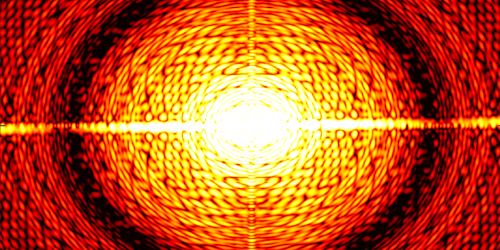Nanostructures Control Ultraviolet Light Generation
Pulses of extreme ultraviolet (EUV) light are used to study very fast processes and very small things. Generating these pulses has become routine with a technique called high-harmonic generation, which uses an “upconversion” material to transform low-frequency pulses to high-frequency ones. The trouble comes when trying to manipulate this generated EUV light, as most lenses and mirrors don’t work at these high frequencies. A new experiment shows that etching nanostructures in the upconversion material can provide a knob for controlling the emitted light at the location where it is generated [1]. This enhanced capability could help in probing computer chips and biological cells with EUV light.
In high-harmonic generation, multiple visible or infrared photons are absorbed by a single atom or molecule within an upconversion material. This excited particle subsequently emits a single photon, whose frequency is an integer multiple of the original frequency. In most cases, the material is a gas. However, recent interest has turned to solid materials, which can be structured to provide some control on the properties of the emitted light.
In their experiments, Sylvianne Roscam Abbing from the Advanced Research Center for Nanolithography in the Netherlands and her colleagues shined infrared laser pulses on solid silica targets that were etched with diffraction grating patterns. The team observed diffraction of the pulses even when the grating spacing was smaller than the input laser’s wavelength, implying that the nanoscale grating affected the outgoing EUV light. Rotating the grating relative to the input laser’s polarization direction, the researchers showed that they could control other aspects of the EUV light, such as its final polarization state.
–Michael Schirber
Michael Schirber is a Corresponding Editor for Physics Magazine based in Lyon, France.
References
- S. D. C. Roscam Abbing et al., “Extreme-ultraviolet shaping and imaging by high-harmonic generation from nanostructured silica,” Phys. Rev. Lett. 128, 223902 (2022).




